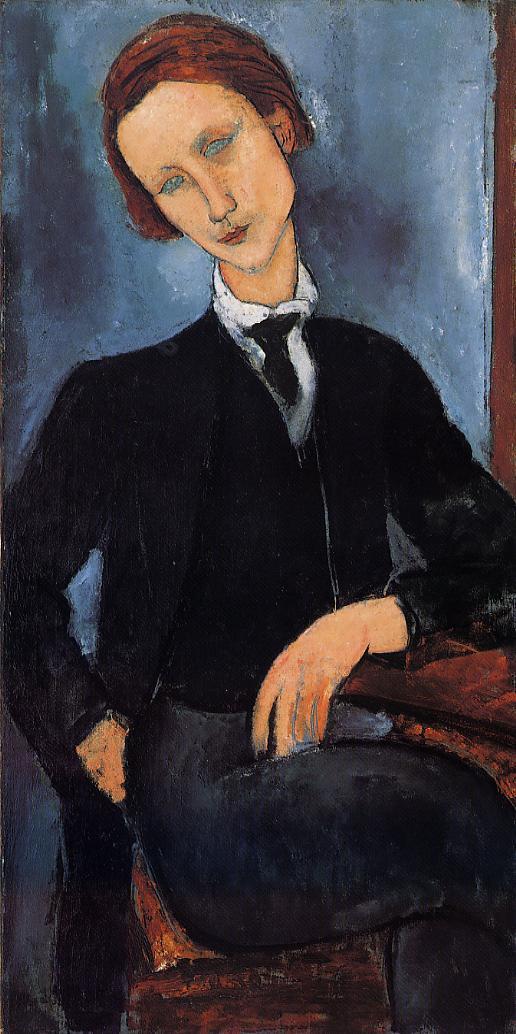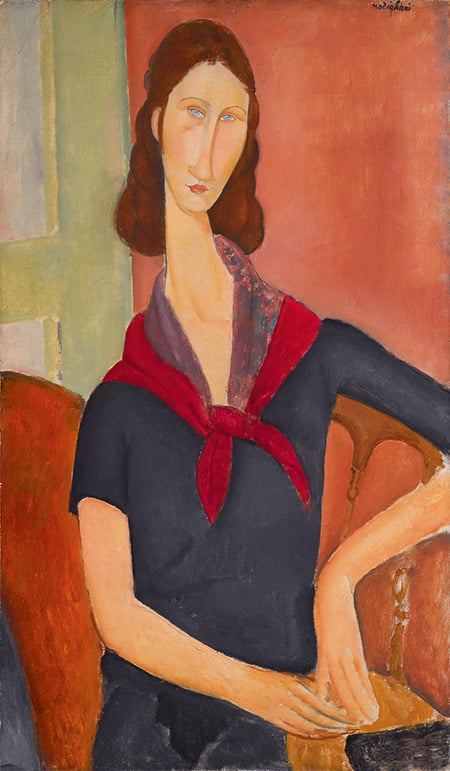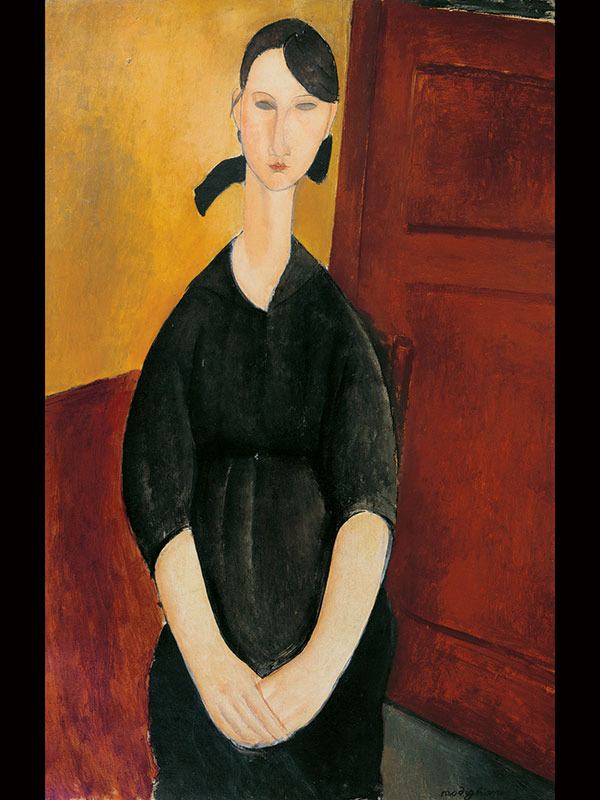Also see
Amedeo Modigliani at Auction and at the National Gallery of Art
The upcoming London Evening sale of Impressionist & Modern Art is also led by a stunning portrait of a youth by Modigliani Jeune homme assis, les mains croisees sur les genoux, by Amedeo Modigliani painted whilst the artist was living on the French Riviera.
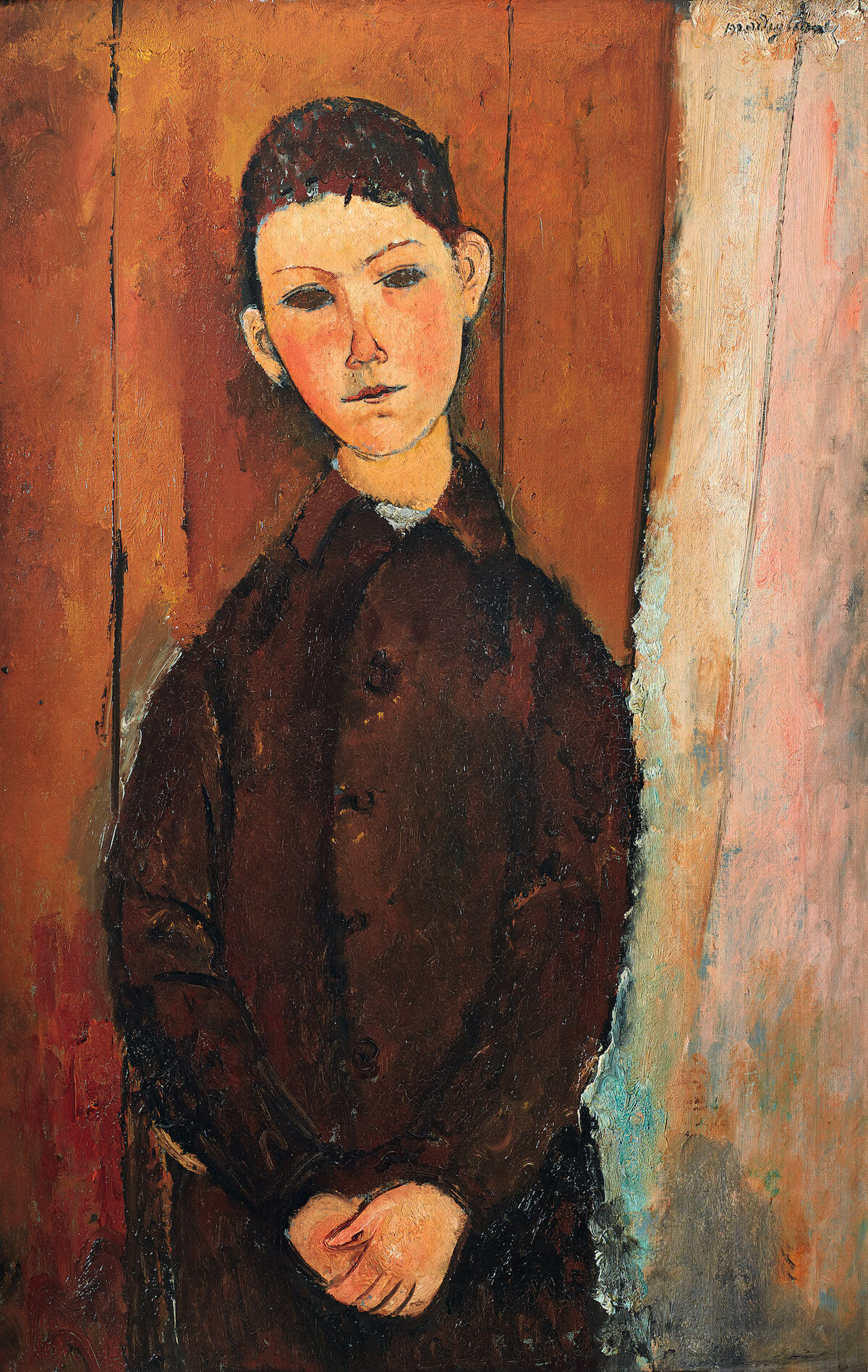
Amedeo Modigliani, Jeune homme assis , les mains croisées sur less genoux , 1918, oil on canvas (est. £16,000,000 - 24,000,000 / $ 20, 400,000 - 30,600,000 )
James Mackie, Head of Sotheby’s Impressionist & Modern Art Department in London , said: “A tender and transfixing image of a youth, this intimate portrait presents an unidentified young model with a sense of empathy, poignancy and serene beauty characteristic of the artist’s most accomplished paintings. The work was bought directly from the artist’s dealer Léopold Zborowski in 1927, and has been in the same family collection since then. For decades it has only been published as a black and white image, and will now emerge in its full splendour at auction this month. ”
Modigliani’s transcendent portraits of anonymous youths are among the rarest in his oeuvre , with just a handful of depictions of such male sitters known – many of which are housed in museums across the world. Towards the end of the First World War , as his health worsened, Modigliani sought safety and solace in the French Riviera. During his time in Provence, the artist felt a close connection to Cézanne and the legacy of his great portraits, an influence that is felt in these works. Having spent years immersed in the bohemian circles of Paris, in Nice and Cagnes Modigliani turned to painting anonymous sitters, execut ing a number of sublime portraits of pe a sants, servants, shop girls and children. The figures are ennobled with Modigliani’s elegance, but not at the cost of their innate character and humanity. With his mannerist elongated features and almond - shaped, vacant eyes , the model presents a powerful synthesis of all the characteristic traits t hat make Modigliani’s portraits so immediate and universal. mannerist elongated features and almond - shaped, vacant eyes, the model presents a powerful synthesis of all the characteristic traits t hat make Modigliani’s portraits so immediate and universal.
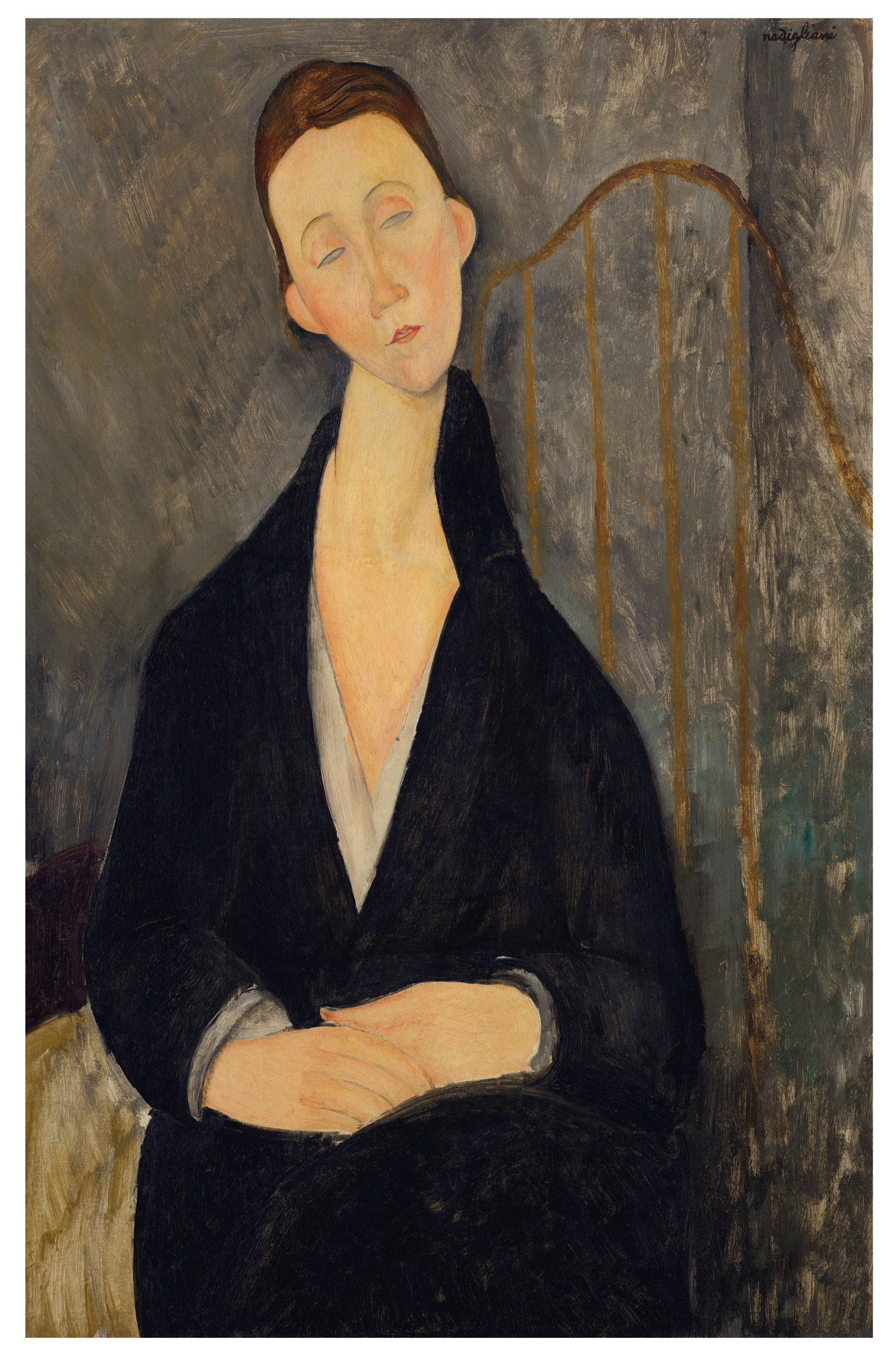
Amedeo Modigliani (1884-1920) Lunia Czechowska (à la robe noire), 1919. Oil on canvas. 36 ⅜ x 23 ⅝ in (92.4 x 60 cm). Estimate: $12,000,000-18,000,000. This work is offered in the Impressionist & Modern Art Evening Sale on 13 May at Christie’s in New York. The Collection of Drue Heinz.
Amedeo Modigliani, Nu couché (sur le côté gauche). Signed Modigliani (lower left). Oil on canvas, 35¼ by 57¾ in.; 89.5 by 146.7 cm. Painted in 1917. Estimate in excess of $150 million. Courtesy Sotheby’s.
Amedeo Modigliani’s stunning Nu couché (sur le côté gauche) is estimated to sell for in excess of $150 million in Sotheby’s Impressionist & Modern Art Evening Sale on 14 May 2018 – the highest estimate ever placed on a work of art at auction.
Painted a century ago, Nu couché is the greatest work from the iconic series in which Modigliani reinvented the nude for the Modern era. Upon their debut exhibition in 1917, these striking and sensual images stopped traffic – quite literally – and prompted the police to close the show. Today, the series is recognized as one of the seminal achievements in Modern painting. The shock and awe that Modigliani’s nudes continue to elicit was evident most recently during Tate Modern’s celebrated retrospective of the artist’s work that included Nu couché.
In addition to being the finest example from the series, Nu couché is distinguished further as the largest painting of Modigliani’s entire oeuvre – measuring nearly 58 inches / 147 centimeters across – and the only one of his horizontal nudes to contain the entire figure within the canvas.
The majority of the 22 reclining nudes from the series are found in museums, with particular depth in the United States: the Solomon R. Guggenheim Museum, The Museum of Modern Art and The Metropolitan Museum of Art in New York each hold three examples. Outside of the United States, institutions with reclining nudes include the Long Museum in Shanghai and The Courtauld Gallery in London.
Nu couché was acquired by the present owner at auction in 2003 for $26.9 million. In 2015, another reclining nude from the series sold at auction for $170.4 million, at the time marking the second-highest price ever paid for a work of art at auction.
Simon Shaw, Co-Head Worldwide of Sotheby’s Impressionist & Modern Art Department, commented: “This painting reimagines the nude for the Modern era. Modigliani depicted his models as confident and self-possessed in their sexuality. Nu couché is an incredibly sensual image, with the sitter’s gaze meeting the viewer’s head-on in truly mesmerizing fashion. While situating itself within a classical canon of nude painting, the work is radically innovative in style: Modigliani assimilates a world of visual cultures across the centuries, from Egyptian, Japanese, African, Indian and Iberian sculpture, from Renaissance frescoes through Romanticism to the cutting-edge of Cubism. Together these pictures signal a watershed in perhaps the greatest tradition in art – there is the nude before Modigliani, and there is the nude after Modigliani.”
Modigliani began painting nudes in 1908, but it was only after he abandoned sculpture in 1914 that he developed the unique idiom evident in Nu couché. His aesthetic was gleaned from the artistic precedents of Italian Renaissance and Mannerist painting, the linear simplicity of African carvings and the earth-toned palette and geometric modelling of Cubism – all of which can be seen in the present work.
The majority of Modigliani’s output was based in portraiture, which, more often than not, depicted those who surrounded him: fellow artists, poets, lovers and patrons. Aside from a veritable who’s who of the more bohemian artistic circles in Paris, Modigliani would also seize upon chances to find other sitters – though the opportunities for unpaid models were few and far between.
It was not until Modigliani’s dealer Léopold Zborowski stepped forward with both a space and paid models that Modigliani embarked on his great series of nudes. Zborowski provided the artist a stipend of 15 Francs a day, and paid the models five Francs to pose in an apartment just above his own at 3 Rue Joseph Bara.
Draped in sheets, perched on chairs, reclining on sofas or beds, the models are relatively anonymous – Modigliani did not paint his prime paramours in the nude. But while he may have had emotional distance from the sitters, he certainly did not have physical distance: the women dominate their space, filling the frame with stretching hands and feet, forearms and calves literally off of the edges of the canvas. Their nudity is self-assured and proud, not cloaked in myth or allegory.
In total, Modigliani completed 22 reclining nudes and 13 seated nudes between 1916 and 1919, with the majority – including the present work – painted in 1917. And from the first moment the works were displayed that year, they stopped traffic.
At the request of Zborowski, Parisian dealer Berthe Weill staged an exhibition of Modigliani’s paintings and works on paper. In the window of her gallery – by some accounts directly hung in the window, and by others clearly visible through it – were a number of the nudes.
Upon opening, crowds immediately gathered in the exhibition to witness the strikingly-real works, and traffic began to build up outside. Across from Weill’s gallery was a police station, and the commotion did not go unnoticed. An officer traipsed across the road and asked for the removal of the offending canvases, which he considered indecent. Weill’s refusal to do so found her in the police station speaking with the police chief. The show was closed with Zborowski only selling two drawings at 30 Francs each.
Over 100 years after its creation, the power of Nu couché to amaze and startle remains as potent as it did in 1917.
Amedeo Modigliani
Portrait of Baranowski
oil on canvas
Painted in 1918.
Estimate: £10,000,000-15,000,000
Painted in 1918.
Estimate: £10,000,000-15,000,000
“To do any work, I must have a living person, I must be able to see him opposite me” – Modigliani
Working in Paris for most of his career, Modigliani is today considered one of the excess of $100 million and last June, Sotheby’s London sold Jeanne Hébuterne (au foulard) – one of the greatest portraits the artist painted of his most loyal muse – for $56.6 million.
Portrait de Baranowski, depicting a young man with fragile goodlooks and a pensive, introspective air, is a wonderfully elegant composition that powerfully synthesises all the elements of Modigliani’s portraits in this period – from geometricsimplification of the stylised human form to the almond, vacant eyes that render the sitter impenetrable.
A Loving Tribute to his Eternal Muse: One of the Finest Portraits by Modigliani in Private Hands
Amedeo Modigliani’s Jeanne Hébuterne (au foulard) will be offered alongside Pablo Picasso’s Cubist masterpiece of his lover Fernande Olivier. This elegant and lyrical work is among the most beautiful portrait s Amedeo Modigliani painted of his lover Jeanne Hébuterne – revealing a tender moment between a pioneer in the world of modern art and his most loyal muse. The painting brings together the very best of the highly refined aesthetic that Modigliani had developed in the last few years before his premature death whilst giving the viewer a glimpse into one of the most poignant love stories in 20 th - century art history . Having been in a private collection since 1986, this exquisite work is expected to fetch in excess of £28m (in excess of $40m ) as part of Sotheby’s Impressionist & Modern Art Evening sale on 21 June 2016 .
Modigliani forged a uniquely evocative style, inspired by a fascination with the Old Masters of his native Italy and the influence of the avant - garde artists he had met in Paris , including Pablo Picasso and Constantin Brancusi. Jeanne Hébuterne (au foulard) powerfully synthesises all of the most iconic characteristic traits associated with the artist’s late portraits – from the geometric simplification of the female form and the flowing melodic lines and to the elo ngated neck and face so heavily reminiscent of his stone carvings ( such as the exceptional Tête , which sold at Sotheby’s New York for a record $ 70.7 million in November 2014) . H is lover is given a pair of piercingly blue eyes, contrasting with his usual ‘almond’ vacant eyes, endowing the sitter ith a dominant sense of personality and draw ing the viewer in. She is also shown here seated in full three - quarter length splendour in a vibrant coral interior , her arms draped elegantly over of the back of her chair, her scarlet silk scarf knotted around her swan - like neck.
The final years of Modigliani’s life were marked by tragedy. but resulted in many of his most celebrated works. Modigliani moved to Paris in 1906 and within a year, he had cultivated a reputation as a drunk and voracious drug user . However, his escalating intake of drugs and alcohol may have been a means by which he masked his tuberculosis – those who had the illness were feared and ostracised and Modigliani’s penchant for camaraderie meant that he could not bear to be isolated. Jeanne met Modigliani in 1917, when she was a young art student, and for the next three years she was his constant companion and source of inspiration. The two were devoted to each other – with Modigliani even pledging to marry her, despite her family’s protestations. Indeed, it is the portraits of Jeanne painted during the last years of his life are his most refined and accomplished works.
In January 1920, after not hearing from him for several days, a neighbour checked on the family and found Modigliani in bed delirious and holding onto Jeanne . Not long after, Modigliani died of tubercular meningitis. Following the funeral, a twenty - two year old, and reputedly heavily pregnant, Jeanne was taken to her parents' home. There, inconsolable, she committed suicide by leaping from an upstairs window. A single tombstone at the Père Lachaise cemetery in Paris now honours them both. His epitaph reads, "Struck down by Death at the moment of glory, hers "Devoted companion to the extreme sacrifice".
The serene calm of Jeanne Hébuterne (au foulard) is in sharp contrast to the tales of Modigliani’s notorious drunkenness and bohemianism. The richness yet subtlety of the colours attest to an emotional and psychological dimension found in the portraits of Jeanne, but rarely seen in his other works.
Also featured is Amedeo Modigliani’s (1884-1920) Jeune femme à la rose (Margherita) (estimate: $12,000,000-18,000,000) painted in 1916. This portrait is a quintessentially modern painting of the female figure painted in Modigliani’s signature style- with a patrician long neck and oval face, large eyes and small, red lips. Here he adds the uncoventional, and alluring adornment of a rose in the subject’s décolletage, further heightening her seductive allure. It is the finest of a series of three paintings from 1916 recorded by Ambrogio Ceroni that takes a dark haired and brown-eyed young woman as its subject. It has been suggested that the model is the artist’s older sister Margherit
A dedicated evening auction of property from the Estate of A. Alfred Taubman will be led by a selection of rare examples of Impressionist & Modern Art, foremost among them
Amedeo Modigliani’s outstanding Paulette JourdaiOn November 9, 2015 Christie’s will offer
Amedeo Modigliani’s masterpiece Nu couché (Reclining Nude) on Monday, November 9 in New York. The painting, executed in 1917-18, will be the centerpiece of a special curated Evening Sale of 20th Century art focused on the theme of “The Artist’s Muse”.
The painting is one of a series of great female nudes made for Léopold Zborowski that famously caused a scandal nearly a century ago when they were exhibited at Modigliani’s first and only one-man show at the Galerie Berthe Weill in Paris. Outraged by the content of this show — which caused a crowd to form outside the gallery window where one of Modigliani’s nudes was openly on display — the police demanded the immediate closure of the exhibition.
The upcoming sale this November marks the first time this portrait is appearing at auction. Estimated to exceed $100 million, the portrait is poised to break the standing world auction record of $70.7 million for any work by Modigliani, one of the greatest artists of the 20th century.
Jussi Pylkkänen, Christie’s Global President and Chief Auctioneer comments, “This is quite simply one of the most important paintings I have handled in my long career at Christie’s. There are a very small number of masterpieces that we dream of handling: this magnificent Modigliani has always been one of them. This powerful and noble female nude is a work of timeless beauty and one of the greatest works by the artist. It is a particular honour to be entrusted with the sale of this painting as my own area of expertise has always been the early 20th Century avant-garde, the paintings that shook the foundations of convention.” Mariolina Bassetti, Christie’s Chairman and International Director, Italy, added, “This is the painting that defines Modigliani”.
Originally in the collection of Modigliani’s mentor, friend, and dealer, Léopold Zborowski, Nu couché (Reclining Nude) has been so widely and frequently published and referred to over the past century that it has become one of the most recognized images of early 20th century painting and certainly represents one of Modigliani’s best known works. It was also previously in the celebrated collection of the late Gianni Mattioli, one of the greatest champions of Italian early 20th Century Modernism, who organized a global tour of his superb Italian Art collection in the 1960s. In the 1950s, this work toured to the Museum of Modern Art in New York where it took pride of place on the cover of the exhibition catalogue.
The painting has also been featured in major museum shows across the globe, including the Palais des Beaux Arts in Brussels, the Stedelijk Museum in Amsterdam, the Musée National d’Art Moderne in Paris, the Tate Gallery and the Royal Academy of Arts in London, the Museum of Modern Art in New York, and the Palazzo Reale in Milan.
Amedeo Modigliani, Portrait de Béatrice Hastings, oil on canvas, 1916. US $7-10million
- This dynamic portrait depicts Modigliani’s muse Béatrice Hastings, one of many pen names for South African writer, poet and literary critic, Emily Alice Haigh.
- Hastings frequently posed for Modigliani, with whom she shared an apartment in Monteparnasse.
- Modigliani used portraiture, especially of those in his immediate circle, as a means to explore an idealised aspect of humanity, an image of internal as well as external likeness.
- With its expressive painterly surface, Béatrice Hastings, is in glorious physical condition, giving it the appearance of just having left the easel.
Among the star works from the Whitehead Collection to be featured within the May Evening Sale are Amedeo Modigliani’s Portrait de Béatrice Hastings from 1916 (US$7-10million) and Claude Monet’s Paysage de matin (Giverny) (US$6-8million; pictured page one). Together, these works depict the sweeping range of the collection; Modigliani’s portrait representing the dynamism of the European Avant-Garde and Monet’s landscape evoking the purity of French Impressionism with its revelry in light.
Amedeo Modigliani, Portrait de Béatrice Hastings, oil on canvas, 1916. US$7-10million
